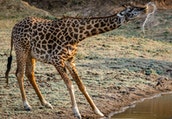- 1. Africa Serval Appearance: The Serval has a slender body, relatively small head with large ears, and long legs. Its coat is yellowish-tan with black spots and stripes, providing excellent camouflage in its grassland and savannah habitats. It has a white belly and facial markings, including prominent white spots on the back of its ears.
- 2. Africa Serval Size: Servals are medium-sized cats, with males typically larger than females. They can stand about 21 to 24 inches (53 to 62 centimeters) tall at the shoulder and have a body length of about 30 to 40 inches (76 to 100 centimeters). The tail adds an additional 12 to 18 inches (30 to 45 centimeters) in length. Adult males weigh between 20 to 40 pounds (9 to 18 kilograms), while females are slightly smaller, weighing between 15 to 25 pounds (7 to 11 kilograms).
- 3. Africa Serval Habitat: Servals are primarily found in the grasslands, savannas, and wetlands of sub-Saharan Africa. They are well-adapted to both wet and dry environments and can be found in various countries, including South Africa, Namibia, Botswana, Kenya, Tanzania, and others.
- 4. Africa Serval Behavior: Servals are solitary and mostly nocturnal animals, hunting primarily at night. They are excellent hunters and have remarkable agility, using their long legs to leap and catch prey such as rodents, birds, and insects.
- 5. Africa Serval Communication: Servals communicate with a variety of vocalizations, including hisses, growls, purrs, and high-pitched calls. They use these vocalizations to communicate with each other and mark their territories.
- 6. Africa Serval Conservation Status: The Serval is listed as a species of "Least Concern" by the International Union for Conservation of Nature (IUCN). However, their populations can be locally threatened by habitat loss and illegal hunting for their fur and body parts.
Africa Serval
The Serval (Leptailurus serval) is a medium-sized wild cat native to Africa. It is known for its striking appearance, with its distinctive coat and long legs, making it a unique and fascinating animal to encounter during an African safari.
Africa Safari Tour Book online The Okapi safari
Here are some key points about the Serval:
Africa Serval Safari Tour
An Africa Serval safari offers a fantastic opportunity to observe these elusive and captivating wild cats in their natural habitat. While Serval sightings during a safari are relatively rare due to their nocturnal and secretive nature, some game reserves and national parks in Africa are known for having healthy Serval populations, increasing the chances of encountering them. Here are some tips for an Africa Serval safari:
By planning ahead and choosing reputable safari operators or guides, Remember that wildlife encounters are just one aspect of an Africa safari, and the journey offers the opportunity to connect with the continent's rich biodiversity, stunning landscapes, and diverse cultures. Whether or not you have the chance to spot a Serval, your safari experience is sure to leave you with unforgettable memories and a deep appreciation for Africa's natural wonders.
Africa Serval Safari Destinations
Choose the Right Safari Destination: Look for safari destinations that are known for supporting healthy Serval populations. Countries with significant Serval populations include South Africa, Namibia, Botswana, Kenya, Tanzania, and others. Reserves and parks with diverse ecosystems, such as grasslands and wetlands, are more likely to be Serval habitat.
Africa Serval Experienced Safari Guides
Experienced Safari Guides: Select a safari operator with experienced guides who are knowledgeable about local wildlife, including Servals. Expert guides can track the animals, understand their behavior, and increase the likelihood of a successful sighting.
Africa Serval Nocturnal Safari Activities
Nocturnal Safari Activities: Given that Servals are primarily active at night, consider participating in nocturnal safari activities, such as night game drives or guided walks. These activities are specifically designed to encounter nocturnal animals, including Servals.
Africa Serval Patience and Flexibility
Patience and Flexibility: Wildlife encounters are unpredictable, and sightings cannot be guaranteed. Be patient and keep an open mind, as every safari experience is unique, and you may encounter other fascinating wildlife during your journey.
Africa Serval Respect Wildlife
Respect Wildlife: Always prioritize the well-being of the animals and respect their natural behavior. Observe Servals and other wildlife from a safe and respectful distance, and refrain from disturbing or approaching them.
Africa Serval Responsible Wildlife Viewing
Responsible Wildlife Viewing: Always prioritize the safety and well-being of the animals during your safari. Observe rhinoceros from a safe distance and follow the guidance of your safari guide to minimize any disturbance to the wildlife.
Africa Serval Photography Opportunities
Photographic Opportunities: Bring a camera with a zoom lens to capture wildlife sightings, including Servals, and preserve these precious moments. Always follow ethical wildlife photography practices and avoid using flash or other disruptive techniques.
Africa Serval Conservation Awareness
Conservation Awareness: Learn about the conservation efforts aimed at protecting Servals and other wildlife in the region. Support responsible and sustainable tourism practices that contribute to the preservation of these beautiful creatures and their habitats.








 |
|  |
|  |
|  |
| 